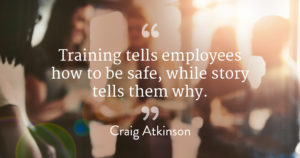
Intrinzic’s Rob Pasquinucci recently sat down with Craig Atkinson, Vice President of Communications and Strategic Services at The Walsh Group and Safety Week Committee Chair, to discuss how storytelling techniques have the power to motivate audiences across an entire industry.
Rob: We just wrapped up another successful Safety Week campaign. One of the elements that has been a key part of the campaign over the last few years is a push to go beyond merely telling workers to “do safe things,” but to develop narratives that rally workers to consistently WANT to make safe choices. Why did the committee choose to do this?
Craig: We need to engage the head and the heart to create a strong, sustained safety culture. Yes, it’s essential that we in the construction industry make sure workers know what to do to be safe and how to perform these tasks, lasting behavioral change can only come when we engage the hearts of workers by sharing compelling stories and encouraging them to share with each other, so they have a personal reason why they want to make sure everyone gets home safe each night.
Rob: Tell us a little bit more about what you consider storytelling.
Craig: Storytelling literally goes back to the beginning of time. It’s the way humans have communicated across millennia. To me, good storytelling has two elements . One, it’s easy to remember and identify, and two, it can be shared readily.
Rob: Why is storytelling so crucial in developing a safety culture?
Craig: A big piece of storytelling’s effectiveness is that it is traditionally seen as a way to communicate values. Think of the concept of the “moral” of the story. You can tell your kids to not lie, or you can tell them the story of the boy who cried wolf. In our industry, we can tell our people to wear personal protective equipment, or we can tell a relatable story. Stories allow us to overlay our experiences with the person being featured. We walk in their shoes (or boots) and see the world through a different perspective.
Rob: Does storytelling replace traditional training?
Craig: Not at all. Training tells employees how to be safe, while story tells them why. Both are crucial elements to building culture and communicating lasting values.
Rob: How can brands get better at developing stories?
Craig: For me, it starts by finding the human element. Too often, we lead with the facts, figures, rules and regulations. If we’re rolling out a new policy, start by talking about how a group of workers had a problem and developed this great solution as opposed to going through the nuts and bolts of what people need to do to adhere to the policy.

